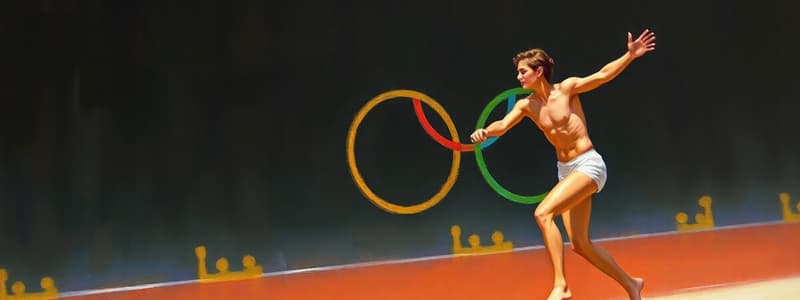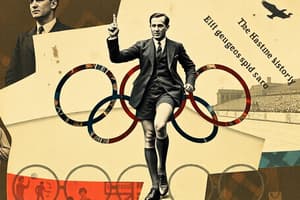Podcast
Questions and Answers
Quel était l'un des principaux espoirs de Pierre de Coubertin en promouvant les Jeux olympiques ?
Quel était l'un des principaux espoirs de Pierre de Coubertin en promouvant les Jeux olympiques ?
- Accélérer le développement du nationalisme.
- Renforcer les alliances politiques entre les grandes puissances.
- Promouvoir la supériorité militaire des nations européennes.
- Établir un siècle sans guerre en détournant les conflits vers le sport. (correct)
Comment la France républicaine du 19e siècle se distinguait-elle des autres nations en termes de développement sportif ?
Comment la France républicaine du 19e siècle se distinguait-elle des autres nations en termes de développement sportif ?
- En limitant l'accès au sport aux seules classes aristocratiques.
- En ignorant le développement sportif au profit d'autres formes de divertissement.
- En mettant l'accent sur le sport comme un outil de propagande nationaliste.
- En intégrant le sport dans un idéal républicain de démocratie et d'égalité. (correct)
Quel rôle l'urbanisation a-t-elle joué dans la renaissance des Jeux olympiques à la fin du 19e siècle ?
Quel rôle l'urbanisation a-t-elle joué dans la renaissance des Jeux olympiques à la fin du 19e siècle ?
- Elle a diminué l'intérêt pour les événements internationaux.
- Elle a transformé les villes en enjeux majeurs pour les JO. (correct)
- Elle a favorisé le retour aux valeurs rurales et traditionnelles.
- Elle a rendu plus difficile l'organisation des compétitions sportives.
Quelle était la vision du sport comme 'vision culturelle' au 19e siècle, notamment à travers l'exemple de l'alpinisme ?
Quelle était la vision du sport comme 'vision culturelle' au 19e siècle, notamment à travers l'exemple de l'alpinisme ?
Comment l'image du corps a-t-elle évolué au 19e siècle, et quel rôle cela a-t-il joué dans le contexte des Jeux olympiques ?
Comment l'image du corps a-t-elle évolué au 19e siècle, et quel rôle cela a-t-il joué dans le contexte des Jeux olympiques ?
Parmi les tentatives de rétablissement des Jeux olympiques avant 1896, laquelle a consisté à rendre hommage à la république sur les champs de mars à Paris ?
Parmi les tentatives de rétablissement des Jeux olympiques avant 1896, laquelle a consisté à rendre hommage à la république sur les champs de mars à Paris ?
Quel était le rôle principal de l'USFSA (Union des Sociétés Françaises de Sports Athlétiques) dans la renaissance des Jeux olympiques ?
Quel était le rôle principal de l'USFSA (Union des Sociétés Françaises de Sports Athlétiques) dans la renaissance des Jeux olympiques ?
Quel événement a marqué la création du Comité International Olympique (CIO) et qui en a été l'instigateur principal ?
Quel événement a marqué la création du Comité International Olympique (CIO) et qui en a été l'instigateur principal ?
Quelles étaient les valeurs fondamentales mises en avant par Pierre de Coubertin lors du congrès de juin 1894 pour les Jeux olympiques ?
Quelles étaient les valeurs fondamentales mises en avant par Pierre de Coubertin lors du congrès de juin 1894 pour les Jeux olympiques ?
Pourquoi Paris a-t-elle été choisie comme l'une des premières villes à accueillir les Jeux olympiques modernes ?
Pourquoi Paris a-t-elle été choisie comme l'une des premières villes à accueillir les Jeux olympiques modernes ?
Flashcards
Fin du 19e siècle
Fin du 19e siècle
Période de paix relative entre la guerre franco-prussienne et la Première Guerre mondiale, favorisant les échanges et les projets internationaux.
Nationalisme
Nationalisme
Mouvement où chaque nation se concentre sur sa propre identité et défend ses intérêts.
Idée de Coubertin
Idée de Coubertin
Faire s'affronter les nations dans le sport plutôt que dans la guerre.
Mondialisation de l'économie
Mondialisation de l'économie
Signup and view all the flashcards
Vision culturelle du sport
Vision culturelle du sport
Signup and view all the flashcards
USFSA
USFSA
Signup and view all the flashcards
7e anniversaire de l'USFSA (1892)
7e anniversaire de l'USFSA (1892)
Signup and view all the flashcards
Valeurs des JO
Valeurs des JO
Signup and view all the flashcards
JO et expositions universelles
JO et expositions universelles
Signup and view all the flashcards
Disciplines des JO
Disciplines des JO
Signup and view all the flashcards
Study Notes
- This note summarizes the context that favored the revival of the Olympic Games (JO).
Context Favoring the Revival of the Olympic Games
- End of the 19th century was a period of peace between two wars, specifically before 1914 and the Franco-Prussian War.
- The Olympic Games were conceived as a pacifist project, aimed at fostering international peace through sports and European collaboration.
- Development of nationalism still occurred during this period, with countries focusing on their nation and defending their territories, leading to talk of race (French, English, etc.).
- Pierre de Coubertin envisioned the Olympics as a way for nations to compete without war.
- Coubertin's hope was for a century without war.
Sports Development in the Late 19th Century
- Sports developed primarily in France and England.
- France, as a republic oriented towards democracy, embodied a republican ideal.
- A favorable social context arose through globalization of the economy, cultural exchanges, and international interactions.
- Urbanization led to cities becoming major focal points in the Olympic Games.
- In Europe, a hierarchical society existed where sports were mainly practiced by the ruling classes (bourgeoisie, aristocracy).
- Sport was seen as a cultural vision, inspiring societies with ideas of adventure such as alpinism.
- The 19th century saw increased importance placed on the body (boxing, wrestling, fencing), with the body's image becoming central to society.
- Physical education gained importance, with increased attention to the body's image compared to earlier times, emphasizing beauty and care.
- The media, including newspapers played a key role.
Attempts to Revive the Olympics Before 1896
- In 1796, the "Olympiades de la République" attempted to revive the games of antiquity.
- Central Paris hosted competitions, including foot races, horse races, relay races, and chariot races in ancient attire.
- These attempts failed due to insufficient funding.
- Archeology was used to stimulate interest in reviving the Olympics.
- Regional games included Scandinavian games, festivals in England, and games in Greece in 1860, but these also lacked sufficient resources.
- These attempts did not proceed further.
Emergence of the Idea for a Global Competition in the 1880s
- USFSA (Union des Sociétés Françaises de Sport Athlétique) was formed and led by Coubertin and Georges de Saint-Clair.
- The USFSA was a multi-sport federation created in 1887.
- It was a fusion of two Parisian clubs created by students: Racing Club de France (1882) which focused on foot races, and Stade Français (1883).
- These two clubs joined to form the USFSA, represented by two rings symbolizing the clubs' grounds.
- Coubertin added two more rings to create the Olympic symbol.
- In 1887, the USFSA's success led to competitions with multiple countries, gradually adding more sports.
- This contributed to the re-establishment of the Olympic Games.
Founding of the International Olympic Committee (CIO)
- In 1892, the 7th anniversary of the USFSA was marked by a meeting of foreign promoters at Coubertin's invitation.
- This meeting led to the founding of the International Olympic Committee (CIO).
- Pierre de Coubertin (1863-1937) was a Parisian aristocrat and military officer.
- He studied in England, where he discovered a multitude of sports, including rowing, boxing, equestrian sports, and rugby.
- Coubertin became a proponent of physical education and aimed to promote it.
Decision to Organize the Olympics Every 4 Years
- In 1894, the Olympic Committee decided to organize the Olympics every four years.
- The June 1894 Congress, led by Coubertin, established core Olympic values.
- Core Olympic values included peace, fair play, and amateurism.
- Amateurism, requiring athletes to be non-professionals until 1992, as exemplified by the Barcelona Olympics.
- The principle of "giving one's best."
- It took until 1908 to write the Olympic Charter.
- Two Olympic Games were organized: in 1896 in Athens, and in 1900 in Paris.
Rationale for Choosing Paris
- The true launch of the Games would occur in Paris.
- London and Paris were major competitive cities.
- The Olympics were organized as part of the Universal Exposition of Paris.
- From the mid-19th century (starting with the first in 1851), universal expositions were organized in major cities like Paris and London.
- The expositions showcased progress in inventions, architecture, and creations, lasting several months.
- The most recent exposition took place in Dubai in 2020.
- Buildings were created for the exhibitions and then often destroyed.
- The Eiffel Tower was among projects created for an exposition and was meant to be torn down after.
Reasons for This Arrangement
- Capitalizing on tourists present between April and October.
- Placing sport within the context of technical progress and modernity.
- The games spanned six months.
- Presented as a form of promotion for sports, including events like tug-of-war, with limited entry restrictions, attracting ~58,000 participants.
- Among the 58,000 participants across all disciplines, only 1,000-2,000 were medalists, and only 50 were women.
- Many countries were represented including Australia, the United States (47 medals), France (94 medals), England (30 medals), and India.
- Cultural Olympiads (theater, dance, music) were organized alongside the sports.
Disciplines During the Olympic Games
- In athletics, the United States dominated in 1900, exemplified by Alvin Kraenzlein's four gold medals.
- Events included the 110-meter hurdles, with athletes taking risks during jumps, and foot races.
- Swimming events took place entirely outdoors in the Seine River, including a swim across Paris.
- An obstacle course competition and underwater swimming were also present.
- Swimming was considered a French sport, while track and field was seen as American.
- Diving competitions also took place.
- Gymnastics focused on showcasing collective performances involving hundreds of individuals.
- Fencing, a French tradition (duel), was the only competition that accepted professionals.
- The spectacle would be improved by including professional fencers as it was a French sport.
- The media contributed to making the Olympic Games a great success.
Studying That Suits You
Use AI to generate personalized quizzes and flashcards to suit your learning preferences.



